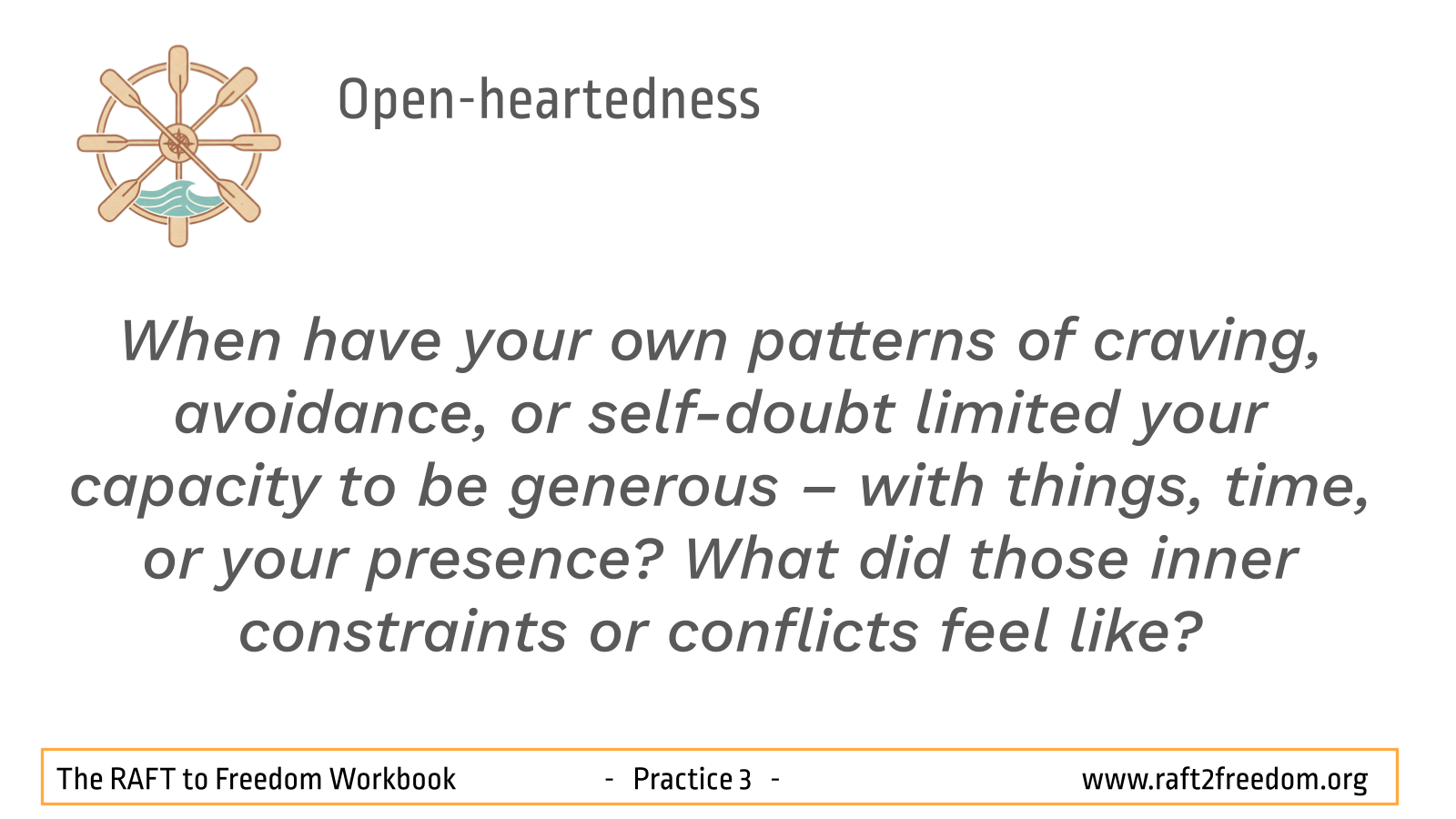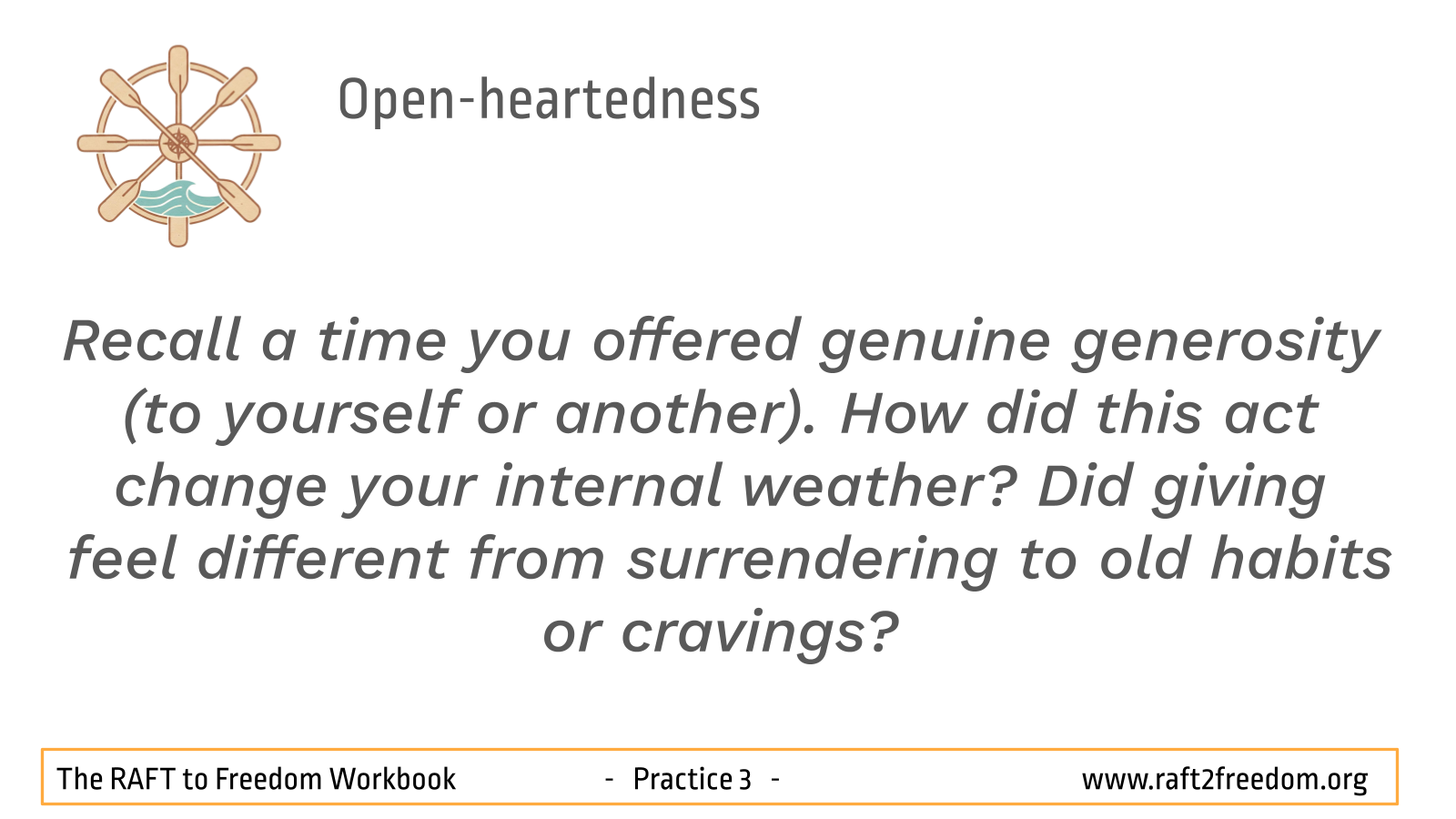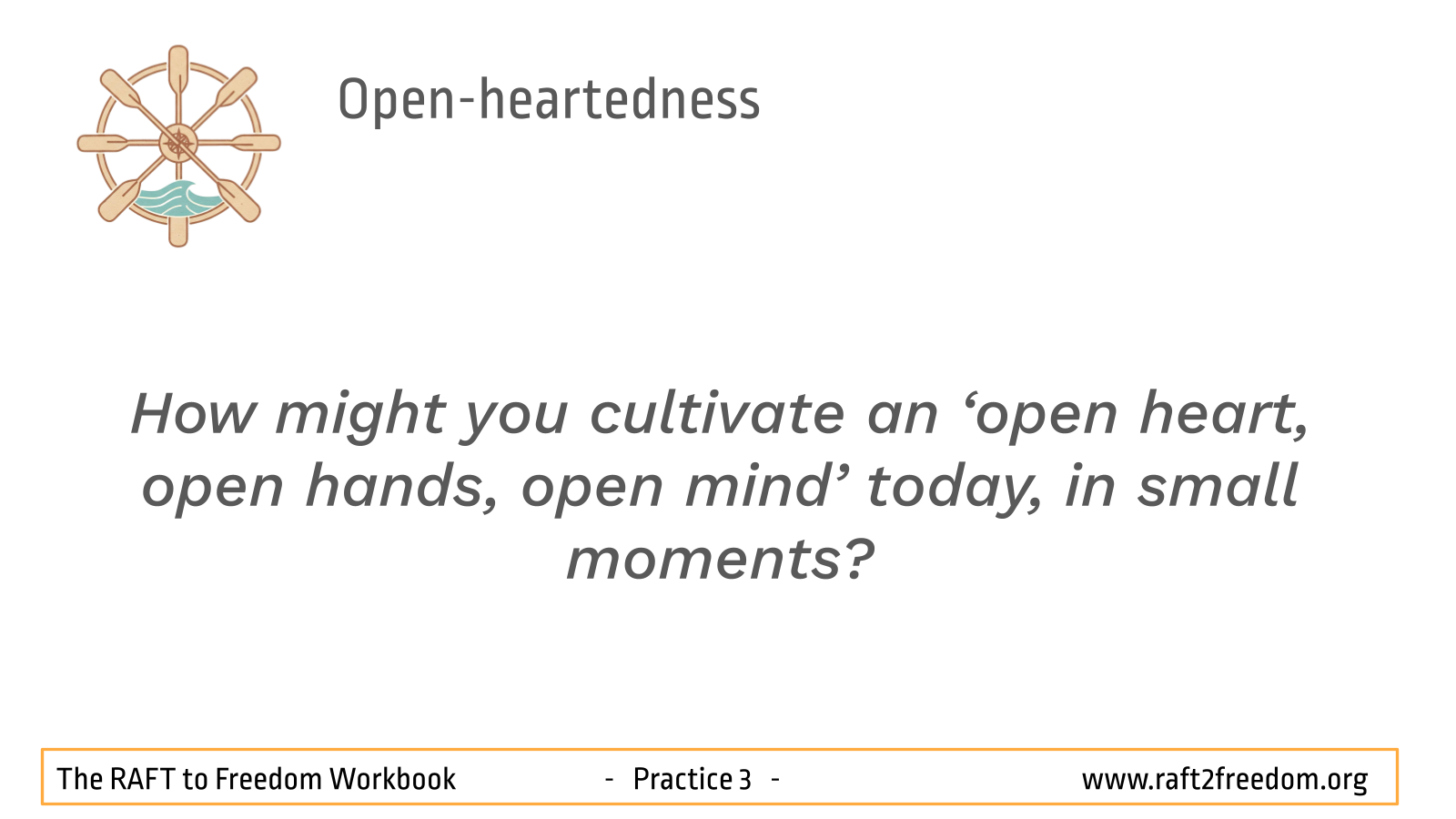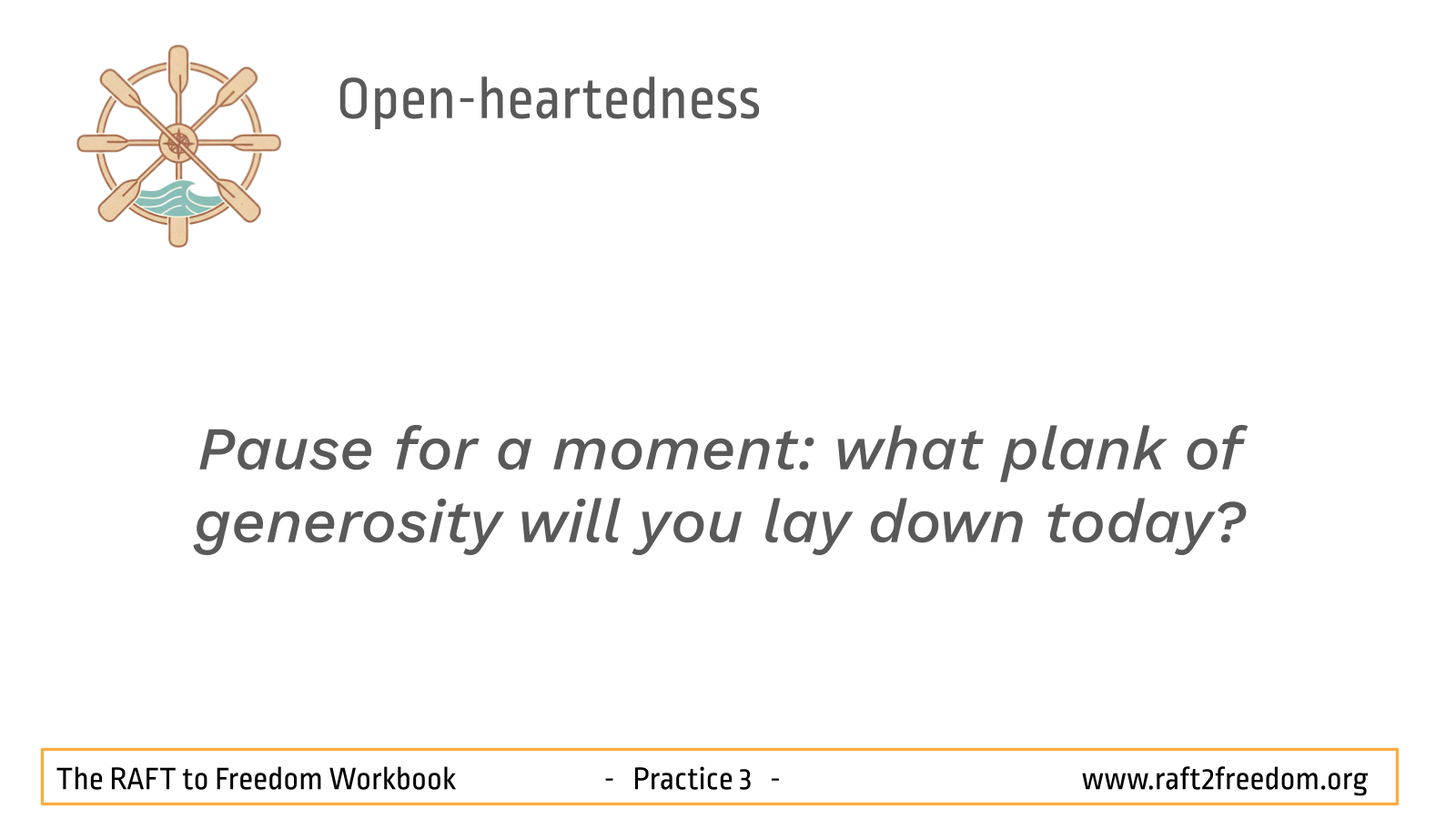Practice 3 – Dana – the gift of generosity
Generosity – the antidote to selfishness
Gathering the first materials with open-heartedness
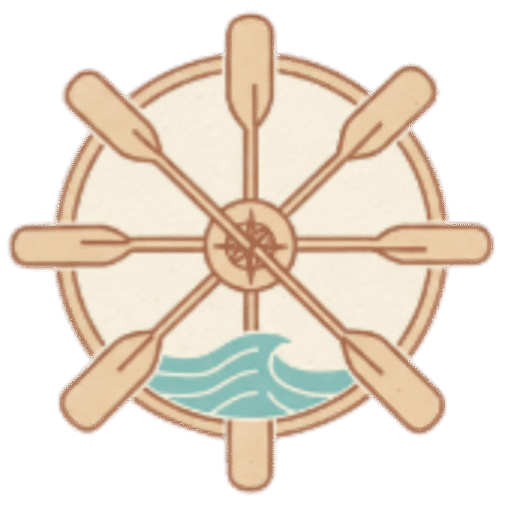
Episode 3 – Dana – the gift of generosity
An AI generated ‘deep dive’ into this aspect of the RAFT to Freedom
If beings knew, as I know, the results of giving and sharing, they would not eat without having given, nor would the stain of miserliness overcome their minds.
Gotama (the Buddha)
Attention is the rarest and purest form of generosity.
Simone Weil
With our journey now begun – surveying the dangerous shore of suffering and disappointment – we now lay our hands upon the first, essential materials for building our vessel to freedom. At the very heart of this process is generosity (dana), which the early Buddhist tradition regards as a powerful, foundational attitude for our journey to freedom.
This practice invites us to begin building our inner raft with one of the oldest and most powerful practices in the Buddhist tradition: generosity. This is not merely about giving things away – it is about cultivating an open-hearted way of being that supports both personal healing and community connection.
Generosity extends far beyond the simple act of our giving away material possessions. It expresses a profound generosity of heart and mind – the deliberate antidote to the tightness, anxiety, and self-contraction that arise alongside our suffering and our human struggle with craving, grasping, and reactivity. Generosity, in this sense, is the opening of our hands, heart, and mind to life itself.
When we intentionally cultivate generosity, we are beginning to gather the initial materials needed to build our raft. With each act of generosity, whether it be a smile, a small kindness to a friend, an hour spent listening to someone in need, or a moment of patience with ourselves – we begin binding the pieces of our vessel together with the ropes of the ‘Appropriate Responses’: compassion, friendliness, appreciative joy, and equanimity (self-compassion, self-love, self-appreciation and self-balance).
When we practice generosity, we naturally foster gratitude and contentment. In Buddhist psychology, these qualities directly counteract our sense of not enough – the root of our harmful cravings and repetitive, self-defeating habits. As one teacher has said, ‘generosity is the antidote to today’s pervading doctrine of insufficiency.’
Gotama taught us that the ‘Five Gifts’ of ethical living (we will discuss these in our next chapter) are ancient and enduring. The very act of undertaking the ‘Five Gifts’ is in itself a form of generosity – giving safety, non-harm, and integrity to others. Each is a moral offering. They form the first five planks of our raft – the gifts of harmlessness – by which we grant ourselves and all beings fearlessness and goodwill. Each time we act generously, we both accept the gift and offer it; the gift becomes a steady platform on our raft to support us on our onward journey.
Generosity is the open hand, freely giving joy, care, and connection.
Harmlessness is the steady hand, refusing to harm ourselves or others.
Together, they steer our raft toward freedom.
Crucially, generosity is not limited to others; it must also be offered to ourselves. Just as a sailor tends their own vessel before setting out, we begin our practice of generosity by offering generosity to ourselves – care, forgiveness, time, and the willingness to start again. This is not selfishness – it is self-compassion: putting on our own lifejacket before helping others. In this way, generosity helps us to recognise the pain, difficulties and disappointments of life, and to meet our struggles and ourselves with compassion – the ‘Appropriate Response’ for this initial stage on the path to liberation.
Our collective journey so far has taught us that the opposite of our destructive cravings is connection. Generosity, shared with ourselves and among our community (sangha) – creates the fellowship and camaraderie needed for us to venture forth towards freedom. Mutual support and generosity allow us to navigate these lonely waters together.
True generosity is available to everyone, regardless of background or circumstances. Because generosity is simply our active intention to align each of our actions, words, and thoughts with our shared purpose of healing and well-being – a conscious forward step towards the safe shore of freedom.
Cultivating generosity:
By offering whatever we can – a dollar, a flower, a word of encouragement – we are training in letting go.
Pema Chödrön
- Self-generosity and forgiveness
- Letting go of harsh self-criticism or unrealistic standards
- Taking time to rest or nourish your body
- Setting a boundary that protects your peace and wholesome intentions
- Practising patience with yourself as you heal and grow
- Allowing yourself to feel joy without guilt
- Generosity of time and presence:
- Actively listening to someone without interrupting or judging
- Offering to run errands or help with childcare for someone overwhelmed
- Volunteering with a community or service organisation
- Being fully present for a conversation, even when busy
- Writing a heartfelt note or message of support or gratitude
- Material generosity (Giving possessions or resources – if you are able)
- Offering food or drink to a guest, stranger, or neighbour
- Donating to a cause aligned with your values (for example, support groups, mutual aid, spiritual centres)
- Sharing your belongings with those in need – clothing, books, tools
- Contributing to a teacher or guide
- Paying forward a coffee or meal anonymously
- Verbal and emotional generosity
- Speaking kind words – even to those who challenge you
- Offering genuine encouragement, praise, or acknowledgment
- Apologising when wrong – without defensiveness
- Sharing wisdom or skills without expecting credit
- Extending compassion to someone struggling, even silently
- Community and interpersonal generosity
- Including others
- Inviting someone new into a group or gathering
- Sharing your healing story to offer hope
- Teaching someone something you know freely
- Supporting someone’s small business or creative work
- Offering mediation or support in times of interpersonal conflict
- Spiritual and ethical generosity
- Sharing helpful teachings, or insight that supported your own path
- Offering service in community or a spiritual practice group
- Upholding the ‘Five Gifts’ and values that protect others from harm
- Mentoring or being available to those new on the path
- Holding someone in silent metta or prayer during their struggle
Self-reflections
- When have your own patterns of craving, avoidance, or self-doubt limited your capacity to be generous – with things, time, or your presence? What did those inner constraints or conflicts feel like?
- Recall a time you offered genuine generosity (to yourself or another). How did this act change your internal weather? Did giving feel different from surrendering to old habits or cravings?
- How might you cultivate an ‘open heart, open hands, open mind’ today, in small moments?
- Pause for a moment: what plank of generosity will you lay down today?
Journaling prompts
- Binding your raft: Describe your vision of lasting freedom or authentic well-being. How does practicing generosity, in any form, bind your raft and carry you closer to that vision?
- What happens when you give: Write about a recent time when giving – whether material, attention, time, or care, brought you a sense of deep peace or clarity. What sensations or feelings arose?
- Self-care on the journey: Using the RAFT metaphor: Imagine your raft – what act of self-generosity today would serve as an anchor or a fresh plank, steadying you for the onward journey?
- Creating connections: How might generosity, extended to others, create ropes of connection and reduce isolation? Who can you offer a gift of presence or support to today?
Supporting material: scientific and philosophical perspectives
For those interested in the scientific and philosophical underpinnings of the practice of generosity, the following overview highlights key connections.
- Neuroscience: Neuroscience increasingly demonstrates what wisdom traditions have long known: acts of generosity do more than benefit others – they reshape our own minds. While cravings and compulsive habits may offer brief spikes of pleasure, research shows that intentional giving activates regions of the brain associated with reward, social bonding, and sustained well-being (see, for example, the studies of Moll et al., 2006, on prosocial behaviour and reward circuitry). Generosity is shown to reduce chronic stress, increase subjective happiness, and build resilience over time.
- Psychology: Suggests that prosocial acts foster trust, cooperation, and social bonds that have been essential for our survival and flourishing as a species. In giving, we strengthen the very ties – like ropes binding the raft – that hold our communities, and ourselves, together. From an evolutionary perspective, generosity plays a vital role in human society.
- Philosophy: Generosity is more than a transaction; it is the lived recognition of interdependence. Giving generates a virtuous cycle in which both giver and receiver are uplifted, helping to break old cycles of harm and isolation and supporting our aspiration for a purposeful, ethical life. As we consciously build our raft plank-by-plank, generosity ensures both strength and buoyancy for the passage ahead.
Remember to remember
Generosity (dana) lies at the heart of our journey from suffering to freedom. It is the open-handed, open-hearted practice that creates stability, cultivates contentment, and helps us to gather the first materials of our raft. With every act of giving, we gather new materials, bind each plank with kindness and compassion, and ensure our vessel is resilient for the voyage across life’s unpredictable seas. The more we give – to others and to ourselves – the stronger, more joyful, and more spacious our raft becomes.
Generosity (dana) is the first active step from pain toward freedom. It begins our healing. It builds our raft. Every open hand, every shared story, every self-kindness strengthens the vessel we sail in. And the more we give, the lighter the journey becomes.
Generosity supports relinquishing, which supports morality, which supports truthfulness, which supports wisdom, which supports equanimity, and so forth.
Allan Lokos
We make a living by what we get, but we make a life by what we give.
Norman MacEwan
The RAFT to Freedom programme is freely offered with open hands and open hearts, as Cathryn and Vince’s practice of generosity. If you would like to contribute towards the running costs of RAFT to Freedom, please email contact@raft2freedom.
Sutta References
- Abhisanda Sutta (AN 8.39 – Rewards)
- Summary: This sutta details the five great gifts (the Five Precepts) that are original, long-standing, and ancient, and how undertaking them gives limitless freedom from fear, enmity, and ill will to countless beings, while also benefiting oneself with unlimited freedom.
- Dhammapada (Verse 354)
- Summary: This verse proclaims that the gift of the Dhamma (teachings) surpasses all other gifts, and the joy derived from it surpasses all other joys, highlighting the ultimate value of wisdom and liberation.
- Alagaddupama Sutta (MN 22 – The Simile of the Snake/Raft)
- Summary: While not explicitly about Dana, this sutta provides the central metaphor of our workbook, teaching that the Dhamma (which includes practices like Dana) is like a raft, built for crossing the flood of suffering to liberation.
- Itivuttaka 26
- Summary: This discourse is the direct source for the chapter’s opening quote. The Buddha states that if people understood the profound results of giving as he does, they would never fail to share before eating, and the heart would be free from the stain of selfishness. This highlights generosity as a direct path to a purer, more open mind.
| RAFT to Freedom © 2025 by Dr Cathryn Jacob and Vince Cullen is licensed under CC BY-NC-SA 4.0. To view a copy of this license, visit https://creativecommons.org/licenses/by-nc-sa/4.0/ |
